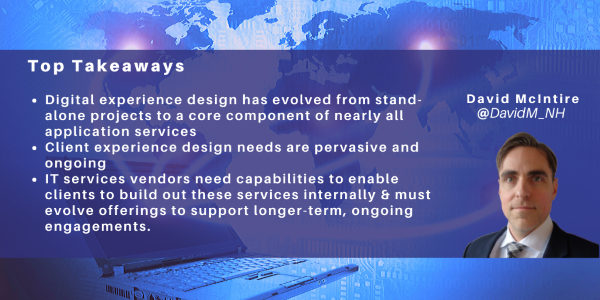posted on Jan 23, 2020 by NelsonHall Analyst

In a recent NelsonHall survey of IT services buyers, the most highly-sought benefit of digital transformation engagements was improving customer experience and customer satisfaction (highly important to ~68% of buyers globally). This focus has driven IT services vendors to invest heavily over the last several years in expanding their experience consulting and design capabilities. In the same survey, ~75% of buyers identified an ability to provide UX consulting and design as a highly important trait sought in vendors.
A major shift in client attitudes
These findings underpin a major shift in IT service client attitudes toward experience consulting and design: it is no longer an optional or standalone activity; it is now a core component of IT. Historically, digital experience consulting and design services were focused on a sub-set of a client’s IT landscape –primarily customer-facing digital properties such as e-commerce sites and client portals. Experience design projects became one-off initiatives to drive the redesign and development of these external-facing applications.
Now, experience is a factor in all application development work. Clients are as likely to seek experience consulting and design services for employee applications as they are for external applications. It is increasingly recognized that employee satisfaction correlates to the applications utilized in their day-to-day jobs; employees don’t forget the ease-of-use of the Uber app or Amazon website just because they are sitting at their work desk.
Experience focus is expanding
The focus of experience is also expanding. Experience is no longer limited to the interface of an application; it now spans the entire service delivery lifecycle; a customer’s experience is as much defined by how quickly they receive an e-commerce order as the interface used to place that order.
Clients are also recognizing the iterative, ongoing nature of experience design. Developing a user-centric application is not a one-time process; it is ongoing and must constantly evolve as customer demands evolve. Building processes and tools that allow for the capture of user feedback to drive iterative application enhancements is as important, or more, as the research required at the onset of a digital experience design program.
All of these factors make experience pervasive in nearly all IT-focused work, and this is resulting in a change in the services clients are looking for from IT service vendors. Rather than solely looking to vendors for consulting, clients will increasingly look for vendors to inculcate these experience design skills in the client organization itself. The expectations of vendors will not just be to deliver a design thinking session and quickly develop wireframes and lo-fi prototypes to be tested, but also build the capabilities to do this within the client organization itself.
Vendor experience capabilities need to evolve
For vendors, this means that the digital experience capabilities they develop must also evolve. Having designers and design thinking specialists capable of driving client engagements is only half of the requisite offering. Vendors must also be able to build these capabilities in their clients while helping them understand the level of transformation required to maximize the value of building an internal experience design capability. The use of design thinking and rapid prototyping across the organization requires fundamental changes, including greater cross-functional collaboration, changing roles both inside and outside of IT, and expanded change management.
To facilitate this, vendors must be able to provide broad consulting that spans several components, including:
- Training client personnel to conduct design thinking sessions and design experiences
- Defining and implementing design libraries for use within the client
- Delivering organization, culture change, and change management services.
In parallel, there will continue to be specific activities where clients won’t realize the value of building in-house capabilities. Conducting dedicated user research or assessing the applicability of emerging technologies (such as chatbots and AR/VR) may remain specialized functions that clients look for vendors to provide. But with the ongoing, iterative nature of digital experience design, vendors will be tasked with evolving offerings to more cost-effective delivery; for example, offering these through an as-a-service capability.
Experience design is evolving from a niche function to becoming a foundational aspect of nearly all application work. Client demands are evolving in parallel, and successful vendors will expand their capabilities and transform their offerings to focus on enabling their clients in addition to delivering outcomes.
